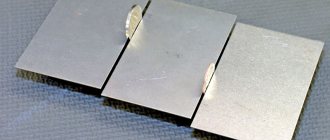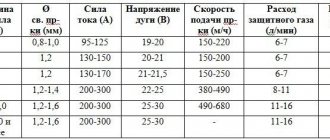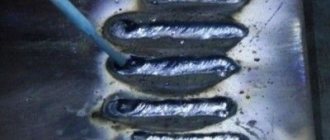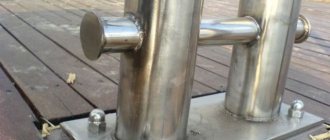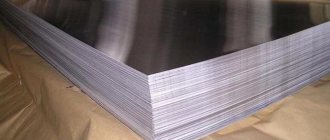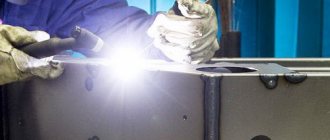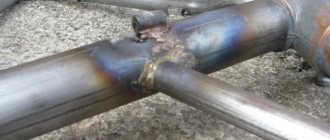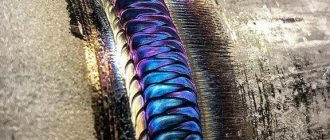How to set the welding current for a novice welder to weld metal from 1 to 5 mm
Welding current is one of the main parameters of electric arc welding. If this parameter is selected incorrectly, then it will not be possible to weld the metal efficiently.
Many errors during welding occur precisely due to incorrectly selected current values. For example, the electrode sticks or metal spatters, welding burns through the workpiece, etc. All this is due to incorrect welding current parameters.
It is difficult for a novice electric welder to decide and select the welding current. This is due to the fact that the welding current depends on many features, including the network voltage. How to set the welding current for a novice welder, read this article.
Preparing, purchasing, stocking up
The most important thing is to know that everything will work out perfectly, because inverter welding technology is very easy to learn and use; experience and skill are not particularly needed here.
Safety precautions
Any welding activity, including an inverter, is directly related to electrical current.
This means that without knowing and following safety rules on how to weld with a welding inverter, you should not start; this is not even discussed.
These rules are simple and straightforward:
- It is necessary to check the cables for integrity and serviceability before connecting to the inverter. It is important to remember: the return cable with a clothespin goes to the negative pole. We attach the cable, where there is an electrical holder, to the positive connector.
- After a visual check, set the current control knob to the minimum value. Then we connect the device to the network. We listen to the operation of the fan when it turns on: if the noise is smooth and without crackling, everything is in order.
- Now let's take into account the considerable weight of the metal with which you will have to work.
Workwear
Welding with an inverter.
First of all, you need to take into account the effect of high temperature and have the following items:
- welder's mask with special light filters;
- protective gloves or gaiter;
- suit made of protective fabric;
- shoes with rubber soles;
- if necessary, a respirator if welding takes place in a closed room without ventilation.
Equipment
List of required equipment:
- inverter welding machine;
- hammer;
- electrodes selected for the type of work, taking into account the nature and thickness of the metal;
- metal bristle brush
Household inverters
A household or home welding inverter is selected according to several parameters. Since it is the simplest, it has few selection criteria.
- Power (welding current rating).
- Power supply parameters.
- Unit price.
- Model.
As for power, there is one important nuance. Dependence on operating conditions applied to the device. What thickness of metal blanks will be welded with it. If you are welding sheets with a thickness of 2-3 mm, then you will have to use an electrode with a diameter of 3 mm. This means that for these works you will need a device with a rated current of 120 amperes. This is the current at which the device will not overheat. In this case it is the maximum value. But you will have to choose this figure 30-50% more. In fact, you should have 160-180 amperes. Why do they do this?
- Domestic power lines cannot provide stable network parameters. This is especially true in rural areas and small towns. Therefore, voltage drops in the network are common. The voltage has dropped, the power of the welding inverter has dropped. The rated current becomes lower, the quality of the weld decreases. The drop in welding current is also affected by the supply cable. A length of more than 15 m and a small cross-section of the wire also affects this indicator not for the better.
- We would like to add that not all manufacturers indicate exact parameters and technical characteristics in the product passport. So it's worth being on the safe side.
- In addition, we note that all household welding inverters have the same functionality. By purchasing a device with more power, no one loses.
The network parameters for household appliances are as follows: voltage 220 volts, drawdowns within 20-30%. Here the minimum value is 150 V, the maximum is 264 V.
There are inverter models on the market that are intended for stable networks. They have different drawdown indicators: from 180 to 253 volts. Such models are best used in urban operating conditions.
Please note that these welding units are immediately switched off when voltage values decrease or increase above those indicated above. And this saves them from failure
True, automatic shutdown is not available on all models.
Not the last word on the question of how to choose a welding inverter for your home and garden will be its price. Here, as in many other things, price determines quality. Although on the market today you can find good welding machines with an optimal ratio of quality and price. But the cheapest ones are Chinese welding devices. These include single-board models. In them, the main parts and elements are collected on one plateau. If it burns out during overload, the cost of repair will be equal to purchasing a new inverter. This model can be identified by the vertically located power connectors for connecting the power cable.
Additional functions
Today, welding inverters with additional functions that simplify the welding process are increasingly appearing on the market.
This is important for beginner welders (as they say in Ukraine).
- The function is called “ARC FORCE” - arc force. It allows the electrode not to stick to the surface of the metal being welded. The rated welding current increases automatically.
- HOT START is a function that simplifies ignition of the arc. If this is done using a conventional welding transformer, then even experienced welders sometimes have difficulty doing it. In the inverter, the current at the electrode increases momentarily, so the arc burns stably.
- ANTI STICK is a necessary feature. With its help, you can get rid of the sticking of the electrode to the surface of the metal parts being welded. The device immediately turns off if the electrode is stuck, because this can cause a short circuit.
And one more selection criterion. Before choosing an inverter welding machine for your home, you need to collect information about service centers in your city that, if necessary, can repair the model you have chosen. If such a center exists, then you can safely buy the device you have chosen.
Let's start cooking
First we set the correct current strength on the inverter. We remember that in inverter technologies, alternating current welding is the main type. The strength of the welding current depends on the composition of the electrode and the diameter of its tip, the position of the workpieces during welding and the type of seam in the planned joint.
All these dependencies can be found in the comprehensive instructions for the device itself and in the inserts in packs of electrodes. Theoretically, the welding current can be selected according to the diameter of the electrode rod: for each millimeter of diameter there should be about 30 A.
We find a comfortable and stable position, put on a mask and begin work with the elbow abducted. It is better to wrap the forearm with a cable. If this is not done, your hand may get tired during welding, and the cable will begin to dangle, which will negatively affect the quality of the weld.
Direction of electrode movement for a novice welder.
For debut work, it is better to choose metal blanks that are not the smallest size - more than 20 cm, this will be more convenient. As beginners usually do: put on a mask, ignite an electric arc and immediately, with one breath, pass the workpiece along the entire length of the seam.
If your part is short and you weld it in one breath, you may develop the unnecessary habit of welding the seam in one breath. Therefore, train on long parts with proper breathing.
Now about the arrangement of objects during work. It is better to place the workpieces on a work table - a horizontal surface. The electrode in the holder should be at right angles to the table plane, then the angle of inclination should be approximately 30°.
Now you need to ignite the arc to move along the planned weld.
Welding can be done at a backward angle, in which case a 30° tilt goes in the direction of the seam. If the angle is forward, the electrode tilts in the opposite direction from the seam. The electrode should be held approximately like a pencil - at a height of 2 mm from the surface of the workpiece.
It must be remembered that when burning, the electrode shortens, so the distance above the surface must be constantly monitored.
How welding current for electrodes affects welding
When carrying out the welding process, it is necessary to select the correct current value. It is this parameter that largely influences the quality of the weld.
Low welding current
can lead to unstable arc combustion, the appearance of unwelded areas, the welding process will be constantly interrupted and, as a result, the welder will receive a poor-quality connection.
A value that is too high will result in overheating or burnout in the welding zone, as well as intense spattering.
In general, the choice of voltage indicators is influenced by several factors :
- brand and diameter of welding materials;
- spatial position of the rod during welding;
- voltage polarity (see the peculiarities of constant and alternating welding);
- seam size ;
- method ;
- type and thickness of metals being welded.
Now about the arc and electrodes
Quickly igniting and holding the arc correctly is perhaps the most important thing for successful welding with an inverter. The arc should not be interrupted - this is what you need to watch out for when the electrode approaches the workpiece plane.
The electrode is ignited in two ways: by tapping or striking. If the electrode is new, it ignites easily. If it has already burned, it is covered with a film of slag, which prevents the consumable from quickly igniting.
In this case, you should tap the electrodes longer so that the film breaks. The relationship between welding current and electrode diameter can be easily calculated using tables that are available in large numbers on the Internet.
Functional diagram of welding with an inverter.
If you have an advanced inverter model, then it is equipped with additional functions that make life easier for beginners and everyone else.
These advanced features are:
- The Hot Start or HotStart function makes it easier to ignite the electric arc.
- Anti-sticking or arc forcing is activated when the electrode approaches the metal surface too quickly. This function increases the current level.
- Antistick or AntiStick, on the contrary, turns off the current to prevent overheating of the welding machine.
It is better to learn from the simplest form of seam - a thread seam, for which the electrode must be guided evenly without any oscillatory movements.
Once you start to feel comfortable with the thread technology, you can start welding metals with oscillating movements in different configurations - there are several of them.
In such cases, you need to make the first few oscillatory movements to form a weld pool. We tilt the electrode at an angle of 30°, no more and no less. Once the pass is completed, you need to beat off the slag crust with a hammer to clean the new seam using a wire brush.
In order for the seam to come out high-quality and aesthetically pleasing, at the end you should make a couple of oscillatory movements towards the metal surfacing. In this way, crater formation can be avoided.
How to learn?
How to learn to cook with electric welding yourself? For training, you will need to properly prepare your workplace. It should be spacious, well lit and equipped with exhaust ventilation. Personal protective equipment for the welder will also be required:
- clothing and footwear made of non-flammable materials;
- split leather gaiters;
- a welder's mask with an adaptive light filter that protects the eyes from arc welding flashes;
- respirator for respiratory protection;
- Safety glasses or a clear face shield for stripping workpieces and seams.
Tools you will need are a wire brush, a hammer, and an angle grinder.
How to connect the electrode?
It is better to start mastering welding technology with electrodes with a diameter of 3 mm. The rod is inserted into the holder with the end cleared of coating and securely fixed with a screw or spring. The cable from the holder is connected to the inverter terminal. The second cable, which has a clamp at the end, is connected to the second terminal. Ferrous metals are welded using the so-called straight polarity - the positive wire is connected to the workpiece with a clamp, and the negative wire is connected to the electrode.
Two types of connection polarity.
Reverse polarity is used for welding stainless steel and other materials.
Beginning: lighting the arc
The arc is ignited using one of two main methods:
- striking with an electrode along the future seam;
- tapping the workpiece.
For beginners, the first method is recommended. If the electrode has already been welded, tapping helps knock off a thin layer of slag from the tip of the rod.
Electrode tilt
The angle of inclination of the rod to the vertical depends on the type of seam
The “backward angle” position is most often used. The working zone follows the tip of the rod, in this case the greatest heating of the metal is obtained. If you tilt the rod in the opposite direction, the heating decreases. This position is used at the end of the seam and when manually welding thin-sheet structures to avoid the appearance of burns and craters.
Movements
The welder must maintain the gap between the electrode tip and the workpiece within 2-3 mm. If it is necessary to ensure a seam width greater than the thickness of the electrode, complex trajectories for its guidance are used.
A novice master needs to master soft and even straight-line driving at a constant speed. After you begin to get even rollers, you can move on to more complex trajectories.
The main task at the training stage is to learn to “feel” and control the state of the weld pool, without overheating or cooling it excessively.
Trajectories of electrode guidance. It is better to learn on workpieces with a thickness of 4-5 mm. After mastering the welding of beads on the plate, you can begin welding two parts.
About welding seams
The seams that are formed using inverter welding are as follows:
- single-pass, in which the thickness of the metal workpiece is replenished in one pass;
- multi-pass, in which one pass of electrodes is not enough. Used when welding thick edges.
The most famous and simple way to check the quality of a seam after welding is to tap it with a hammer. At the same time, the slag layer bounces off - provided that the seam is even and smooth. Also, the quality of the seam depends on the temperature: it must be correct.
If the seam is overheated, it may break; if the heating is insufficient, a very unpleasant thing will happen - lack of penetration.
How to weld metal correctly
Learning to hold the electrode correctly and move the bath is not enough for a good result. It is necessary to know some of the subtleties of the behavior of the metals being joined. The peculiarity is that the seam “pulls” the parts, which can cause them to warp. As a result, the shape of the product may differ greatly from what was intended.
Electric welding technology: before starting to apply a seam, the parts are connected using tack welds - short seams located at a distance of 80-250 mm from each other
Therefore, before work, parts are secured with clamps, ties and other devices. In addition, tacks are made - short transverse seams laid every few tens of centimeters. They hold the parts together, giving the product its shape. When welding joints, they are applied on both sides: this way the resulting stresses are compensated. Only after these preparatory measures do welding begin.
How to choose a current for welding
It is impossible to learn how to weld using electric welding if you do not know what current to set. It depends on the thickness of the parts being welded and the electrodes used. Their dependence is presented in the table.
But with manual arc welding, everything is interconnected. For example, the voltage in the network has dropped. The inverter simply cannot produce the required current. But even under these conditions you can work: you can move the electrode more slowly, achieving good heating. If this does not help, change the type of movement of the electrode - passing over one place several times. Another way is to use a thinner electrode. By combining all these methods you can achieve a good weld even in such conditions.
Now you know how to weld properly. All that remains is to practice the skills. Choose a welding machine, buy electrodes and a welding helmet and start practicing.
To reinforce the information and make fewer mistakes, watch the video lesson on welding.
Polarity forward and reverse: what is the difference
Polarity in welding on an inverter machine is an extremely important thing that you need to understand.
If the welding current is constant, then the movement of electrons is also constant. And in this situation, there is almost no splashing of drops and pieces of molten metal, as a result of which the seam comes out neat and of high quality.
At its core, polarity is the direction of electron flow, which depends on the order in which the cables are connected to two different connectors on the device. Inverters have the ability to select the type of polarity. The welding current can also be adjusted.
Reverse polarity
Types of polarity for welding.
This is the negative pole on the metal workpiece, and the positive pole on the electrode. The current thus moves from minus to plus, that is, from the metal to the electrode. With this method, the electrode gets quite hot. The method is good when welding thin metals as the risk of burn-through is reduced.
Straight polarity
Here it’s the other way around: the negative pole is on the electrode, and the positive pole is on the metal of the workpiece. The current now flows from the electrode to the part being welded, which in this case heats up more than the electrode. This is how they work with thick metal edges.
It should be noted that the polarity is always indicated in the instructions on the packs of electrodes.
One of the main “inverter” questions from debutants is what is the most optimal polarity when welding with an inverter? The answer depends on many criteria, but from the point of view of cutting metal, the polarity should be straight.
The fact is that with this type of polarity, the molten area turns out to be deep and narrow - just what is needed when cutting.
With reverse polarity, the opposite is true: the melting zone is shallow and quite wide.
general information
The main role in welding is played by the arc discharge, which has a high temperature. To create it, the electrode and the workpiece are connected to a voltage source. The discharge melts the metal of the edges of the parts, and it merges into one whole.
The charge carriers in the arc are ionized atoms, molecules and free electrons. As their quantity increases, combustion improves. To do this, components with low ionization potential are introduced into the electrode coating.
According to Ohm's law, the same amount of charge flows through the cross section of any section of an unbranched chain per unit time. It follows that the welding current is limited to the maximum permissible value for this device.
To connect workpieces using the melting method, 2 types of voltage are used:
- permanent;
- variable.
The first provides better quality seams and connections, and less metal spatters.
To connect workpieces, direct and alternating voltage are used.
Cook, cut
If you are working with thin sheets of metal, you need to choose the right small diameter electrode and welding current. If, for example, the edge thickness of your part is 0.8 mm, the diameter of the electrodes should be 1.8 mm. Well, the welding current should reach 35 A. You need to cook using intermittent movements.
The question of which electrodes to weld with is decided taking into account the type of welding and the nature of the metal.
Using an inverter, you can cut metals and even make holes in pipe walls. In order to do this competently and quickly, you need to set the correct parameters on the device. An electrode diameter of 2.5 mm and a current of 140 A are just such indicators.
We ignite the electrode and place it exactly at the location of the planned hole. Press for good heating. We rearrange the electrode, press and heat again. And so on until a hole of the desired shape and size is cut.
If you are cutting sheet metal, the sheet must be fixed vertically. In this case, drops of molten metal will flow down, otherwise you risk getting frozen metal icicles at the bottom of the cut.
To be honest, all cutting of metals with a welding machine, even with the most advanced inverter, is not the best idea from a technical point of view. There is always a risk of metal melting at the cut site - the metal can simply melt out. The best way to cut metal is with a grinder.
How to cook a vertical seam
Welding such seams (slanted and ceiling) is a rather complex process. This is due to the fact that even molten metal is subject to the law of gravity. He is constantly pulled down, which causes difficulties. Beginning welders will need to spend a lot of time learning how to do this.
There are 3 technologies for vertical seam welding:
Triangle. Used when connecting parts with a thickness of no more than 2 mm. Welding occurs from bottom to top. The liquid metal is on top of the solidifying one. It flows down, thereby covering the suture roller. The flowing slag does not interfere, since it moves along the solidified bath, which exits at a certain angle. Externally, the weld pool looks like a triangle
In this method, it is important to move the electrode accurately to completely fill the joint. Herringbone. This type of welding is suitable for gaps between workpieces equal to 2-3 mm
Along the edge from the depth towards you, you need to use an electrode to melt the metal to the entire thickness of the workpiece and, without stopping, lower the electrode to the gap. After melting occurs, do all this along the other edge. You need to continue from the bottom to the top of the weld. This results in a uniform arrangement of molten metal in the gap space. It is important to prevent the formation of undercut edges and metal leaks. Ladder. This method is used when there is a large gap between the workpieces being joined and little dulling of the edges (or its absence at all). Welding is carried out in a zigzag manner from one edge to the other from bottom to top. The electrode stops at the edges for a long time, and the transition is made quickly. The roller will have a small cross-section.
https://youtube.com/watch?v=eNo05v10ToM
Welding polarity
Melting of the metal during the welding process is carried out under the influence of the heat of the arc. It forms between the metal and the electrode when they are connected to opposite terminals of the welding device.
There are 2 options for performing welding work: direct and reverse polarity.
- In the first case, the electrode is connected to the minus, and the metal to the plus. There is a reduced introduction of heat into the metal. The melting point is narrow and deep.
- In the second case, the electrode is connected to the positive, and the metal to the negative, resulting in a reduced heat input into the product. The melting point is wide, but not deep.
When choosing welding, it is necessary to take into account that the network element connected to the plus heats up more. Thick metal is welded with direct polarity, and thin metal with reverse polarity.
https://youtube.com/watch?v=GrVBaIZ3ddE
Tips for dummies
- do not neglect protective equipment;
- Before performing work, it is worth practicing to prevent mistakes;
- welding must be performed with the minimum recommended amperage;
- do not forget to beat off the slag;
- to reduce the deformation of the product, you need to secure the parts during the welding process;
- follow instructions and recommendations.
In addition to the fact that welding can be used to connect parts, it can also be used to cut them. To do this, you need to increase the current and cut off the part or corners. It’s just not possible to do it exactly.
By using this guide, you can gradually improve your skills and use inverter welding without any problems in the future. The main thing in this matter is practice.
https://youtube.com/watch?v=Gc48nLTwTDg
We choose, we buy
Table of characteristics for welding with an inverter.
It would be useful to google and read about domestic and foreign manufacturers whose products are offered on the Russian market. These are mainly European and Asian countries.
Equipment from Asia is usually inexpensive and of very decent quality, with the exception, of course, of handicraft fakes.
European inverters are distinguished by qualities with the obligatory adjective “high” in front: high price, high reliability, high quality. There are few Russian devices on the market.
Understand the brand of welding cable and its cross-sectional area. The right choice will help you avoid difficulties with power surges if they occur during welding.
The second thing to do is figure out the availability of service centers around the country. If you live in a city with a population of one million, a service center for a specific product is unlikely to be a problem for you. But if you live in a remote region, this issue will become one of the most important for you.
To be honest, you won’t be able to buy one device. Be sure to buy a welding helmet with a light filter. You need to protect yourself from splashes of molten metal and combustion products.
But the main thing is protection from ultraviolet radiation from a hot arc. The most primitive option is a mask made of plastic and a light filter, which is selected depending on the current strength, lighting and your vision.
A more expensive and much more comfortable option is a mask with a Chameleon-type light filter, which automatically changes its characteristics and can be adjusted to suit the ambient light and the condition of your eyes.
There are many tables on the Internet with data that will help you choose the right filters. It is better to choose them for a number larger or smaller. The best solution would be to check the lighting in the work area and your vision.
Okay, we agree, you don’t have to buy a whole suit made of special fabric. But a canvas apron with gloves is not a whim, but your protection. It is better to choose mittens from split leather. Pay attention to your shoes: be aware that drops of molten metal may fall on your feet.
Design and advantages of inverter welding machines
The great popularity of inverter equipment among home craftsmen is explained by the fact that with the help of such compact devices, which are also lightweight, it is possible to make high-quality, reliable and accurate welded joints, even without high qualifications.
The design of any welding inverter consists of such elements as:
- power supply with rectifier unit and filter;
- inverter unit that converts direct current into high-frequency alternating current;
- transformer for reducing the voltage of high-frequency current;
- power rectifier designed to produce direct current at the output of the device;
- an electronic unit that performs device control functions.
Controls and structural elements of a welding inverter using the Fubag machine as an example
Innovative technologies implemented in the design of inverters make it possible to obtain high-quality welded joints without any problems. Due to their compactness, such devices do not take up much space, and due to their light weight (5–15 kg), they can be moved anywhere without much difficulty.
If you learn how to operate an inverter welding machine correctly, you can use it to weld any metal structures. Each new inverter comes with instructions, from which the owner of the equipment can glean a lot of useful information: how to properly connect the device, which electrode to choose in order to weld products from a particular metal, etc.
Patterns of electrode movement depending on the type of seam (click to enlarge)
However, often an inverter device falls into the hands of a home craftsman, the instructions for which are not translated into Russian or are missing altogether. It is very important to learn how to work correctly on such an inverter, because if you act at random, it will be difficult to weld metal well. In addition, you may encounter equipment failure.
However, if you follow generally accepted rules, you can work on any model of inverter and effectively solve all the tasks. After carefully studying these rules, watch the training video, which will help reinforce the theoretical material with visuals.
How to care for the inverter?
Any equipment loves care and order, your inverter is by no means an exception. The rules on how to properly cook using inverter welding and how to store it correctly are simple.
Selecting an electrode for welding various metals.
Before work you need to do the following:
- carry out a visual inspection of the device and prepare the place where you are going to work;
- install the inverter in a horizontal position with the desired protection from dust, precipitation and other contaminants;
- connect the cable to the connectors in accordance with your plans, usually this is plus to the electrode and minus to the metal;
- connect power supply. The most important nuance: if you use an extension cord, the cross-section of the welding cable must be at least 2.5 mm².
- ignite the arc at separation as a test test;
- make sure the casing is intact, because cooking without it is strictly prohibited;
- adjust the current mode. You can start cooking.
You must store your device according to the following rules:
- Constantly check all components of the device. The frequency of checks depends on the intensity of use of the device and the degree of dust in the work area;
- Clean the device from dust using compressed air and low pressure. Do not clean the electric plateau with a jet of air, but use a soft brush;
- check the strength of power connectors, the integrity of the plug, socket and insulating coating of electrical cables;
- It is better to store the inverter in dry conditions, the air temperature should be within the range from -15°C to +50°C, the optimal air humidity is about 70 - 80%.
- Remember to disconnect the inverter from the network when it is not working.
Universal table for determining current strength
It is convenient to present the dependence of the amperage and diameter of the consumable on the thickness of the workpiece in tabular form. In this case, the relative position of the parts is taken into account.
For butt joints
The surfaces to be welded are located parallel to each other. Set the following amperage:
| Edge thickness, mm | Consumable diameter, mm | Amperage, A |
| 1,5-2,0 | 1,6-2,0 | 30-45 |
| 3 | 3 | 65-100 |
| 4-8 | 4 | 120-200 |
| 9-12 | 4-5 | 150-200 |
| 13-15 | 5 | 160-250 |
| 16-20 | 6-8 | 200-350 |
| Over 20 | 6-8 | 200-350 |
For corner and T-joints
The surfaces of the workpieces are located perpendicularly. The cross section of the surfacing has the form of a right triangle with a convex hypotenuse. The amperage is set in accordance with the table:
| Seam leg, mm | Consumable diameter, mm | Amperage |
| 3 | 3,0 | 65-100 |
| 4-5 | 4,0 | 120-200 |
| 6-9 | 5,0 | 160-250 |
Physical principles of the process
Before learning to weld independently at home, a novice electric welder must gain an understanding of the basic principles of electric arc welding (hereinafter referred to as ES) and master the theoretical basics of welding with an inverter or welding transformer, so as not to weld “blindly” without understanding the essence work being performed. Electric welding is one of the most common technologies for creating a permanent monolithic connection of metal parts by fusion.
A similar fusion method is currently widely used when joining polypropylene pipes. The only difference is in the melting temperatures of the metals being welded and polypropylene and the type of corresponding equipment, which is why welding of polypropylene elements is often called soldering, and the heating devices used are called soldering irons.
This technique is based on melting the edges of the elements being connected due to the temperature of the electric arc (hereinafter referred to as ED) igniting in the space between the electrode and the base metal. ED is a long-term high-power discharge in a gaseous environment between the electrode and the base metal. The combustion temperature of ED reaches 7000 degrees. C, which exceeds the melting parameters of existing structural metals and their alloys.
The initiation and combustion of ED proceed in the following sequence:
- When the welding electrode rod comes into contact with the prepared edge of the product under the influence of an electromagnetic field, a short circuit is created in the welding electrical circuit.
- When the electrode is removed from the edge of the product by 2-4 mm under the influence of an electromagnetic field, the ED is ignited. The burning arc ensures the conversion of electrical energy into thermal energy, the power of which is sufficient to melt the end of the electrode rod and the edge of the metal being welded.
- In a stable ED combustion mode, stable melting of the material of the electrode rod and the metal of the part/workpiece occurs. Drops of molten metals form a so-called weld pool in the melting zone, which is a layer of molten metal on the surface of the product.
- Together with the electrode rod, the electrode coating melts, creating a gas or gas-slag protective shell around the weld pool and the ED itself, isolating them from the effects of atmospheric nitrogen and oxygen.
- After hardening and crystallization of the weld pool, a strong permanent welded joint is formed.
Important! When welding two parts, the materials of both parts are mixed in the weld pool. This mixture is endowed with the same strength indicators as the metals of the products being joined, which creates a certain advantage of this method compared to other methods of joining products that prevent melting of the material.
- As the ED progresses and the weld pool crystallizes, a weld seam is formed that directly connects both parts.
- pos. 1 – electrode coating, providing gas protection of the weld pool;
- pos. 2 – welding electrode;
- pos. 3 – gas-protective shell formed during evaporation of the electrode coating;
- pos. 4 – local zone of melting of the electrode rod and the workpiece metal;
- pos. 5 – workpiece;
- pos. 6 and 7 – weld surfaces. Dark shade pos. 7 the solidifying, colder part of the weld is highlighted
In practice, electric welding for beginners is implemented as follows:
- the ED is ignited and subsequently maintained at a certain length;
- the electrode is manipulated to give the seam the desired shape;
- the electrode moves along the welding seam guide line;
- stopping the welding process.
Welding instructions
Welding Basics
Before you begin directly welding metal products, you need to study the basic design features of an inverter welding machine. They are presented in the diagram.
The inverter itself has an average weight: up to 7-8 kg. A high-quality instrument has a ventilation grill on the side of the metal case that prevents the transformer from overheating.
There is an on/off button on the back panel. There are two connectors on the front part: “+” and “-”. A cable is connected to them, with an electrode at one end and a clamp at the other. The cables themselves must be of sufficient length and flexible.
Step-by-step instructions telling you how to cook with an inverter correctly.
- Inverter welding begins with the preparation of protective equipment. At your disposal is a welding mask, a thick jacket, and rough, but not rubber, gloves.
- Select an electrode. If you are a beginner, do not use a rod thicker than 4 mm. On the front panel, adjust the desired amperage. Wait a little; If you bring the electrode directly to the metal, sticking will occur.
- We attach the clamp (also called the ground terminal) to the metal surface.
- The arc is ignited. Then we bring the electrode to the metal and touch it a couple of times. Thus, the rod is, as it were, “activated”. The distance at which the electrode is held is usually equal to its diameter.
- During welding, the rod can move according to such patterns.
Ignition of the arc at the beginning of welding + (Video)
Ignition of the arc is the first stage, and beginners have problems with it. First, the rod is tapped a little on the metal to remove the lubricant. A method similar to lighting a match is then used. The electrode is moved over the surface of the product and slightly touched. If the rod suddenly sticks to the metal, it is either abruptly pulled to the side or the inverter is completely turned off.
You need to strike until a bright arc appears. To prevent the arc from disappearing, keep the electrode at a distance of 4 mm from the metal.
How to move the electrode during welding + (Video)
The electrode can only move along certain trajectories. They have already been shown. If you move the electrode only straight, the seam will break. The speed of its movement affects the properties of the seam. If you move quickly, the seam will be narrow and not convex; if you move slowly, it will be wide and convex. At the point where the seam ends, the electrode is held for 3-4 seconds.
How to form a weld seam and avoid defects + (Video)
An uneven seam is most often formed when the electrode moves too quickly. When talking about creating an even and high-quality seam, you need to introduce the concept of a weld pool. The weld pool is that part of the metal that is in a liquid state during welding. The filler material enters this part. The appearance of a pool is a good sign, meaning that welding is proceeding correctly.
The contour of the bath is located under the surface of the metal part. The pool forms a good seam if the welding arc passes evenly and to a great depth into the product. You need to make sure that the seam does not go down, but remains level with the surface. It is easier to create a good connection if you move the electrode in a circular motion. In this case, the bath should be distributed in a circle.
When making seams at the corners, remember that the bath is moving with heat. To control the size of the baths, adjust the arc strength.
The seam will not turn out to be too convex if you hold the electrode close to the vertical position. If you tilt the rod (for example, 45˚), the seam will begin to float. And when the electrode is very close to the horizontal position, the bath begins to diverge and the seam becomes bent. Therefore, the optimal tilt angles are from 45˚ to 90˚.
Arc gap control
The arc gap is the distance between the metal surface and the electrode. The gap at each stage must be the same so that the welding is of high quality and without defects.
If the gap is small, the weld will be too convex, and the material itself will not fuse well. This happens because the product cannot heat up. If there is a large gap, the welding arc will move from side to side, and the seam will come out crooked and weak. The required gap shown in the figure will give good penetration and an even seam.
How to weld thin metal sheets + (Video)
For welding thin metal, it is preferable to use the reverse connection of the inverter, i.e. “-” is attached to the sheet. In this case, the current strength should be at average values. It is better to choose an electrode that will have a long melting time. The MT-2 model is good. It has been used by welders for a long time, so it has proven itself well.
The rod, in the case of thin metal, can be tilted approximately 35˚. First, you carefully bring it closer to the metal, then wait for the red spot to appear and turn into a drop. Move the electrode smoothly so that the droplet remains the same size. This way the seam will be even.
Preparation of the workplace
How to learn to cook with electric welding in a short time? You won’t be able to do this in one day, but by applying tips from various videos and preparing everything you need at your workplace, you can quickly start practicing.
To learn how to weld with a welding inverter, you need a plate for igniting the electrode. It is not always possible to attach the mass to the product, so you will need a small metal table or base
The welder should have a hammer on hand to adjust the correct fixation of metal parts, a slag separator, and a fire extinguishing agent (sand or fire extinguisher). It is important to weld metal with an inverter, being well protected from harmful influences. Regardless of the place of work (home or industrial conditions), each welder must have:
- a protective mask with a light filter corresponding to the lighting in the workplace (with filter No. 5 it will be difficult to see indoors, with filter No. 3 it will be very blinding to the eyes on the street);
- canvas mittens for protection against heat and splashes;
- thick, non-flammable clothing not tucked into the waistband;
- boots;
- headgear to protect against flying drops of slag.
Technology for welding thin metal with an inverter for beginners
To achieve a decent result while maintaining occupational safety, you must adhere to a few simple rules:
- Clean the joints from dirt and possible rust (even if you see that there is no corrosion, just in case).
- Securely secure the workpieces so that they do not move out during the process.
- Preliminarily outline the connection line, so as not to get lost later and not to disturb the desired geometry - with dots every 5–7 cm.
- Complete the work as quickly as possible - without delays in any areas, in one pass.
- Set the minimum current strength - if the device has a smooth adjustment function, this will not be difficult.
- Monitor the open circuit voltage - it is important that it remains at least 70 V.
Converter operation
This is a device with reverse polarity, that is, it is connected to the workpiece with a minus, and to the conductor with a plus. This eliminates the very possibility of defects occurring. The rod heats up stronger and faster than the material at the point of contact, especially if this consumable is of good quality (from a foreign company, with known properties, proven in practice). It is also important that it has high buoyancy and its diameter does not exceed 2 mm.
There are many videos showing how to perform passes. Check out some of them and you'll avoid making common mistakes.
Advantages of thin-walled blanks
Welded strictly according to technology, using modern equipment, with neat seams, they:
- They have an aesthetic and even attractive appearance, because there is no scale on their surfaces.
- Exactly correspond to the design dimensions, not deformed, since during their production the material was not subject to temperature changes.
- They are completely ready for painting or other coatings because there is no slag on them.
- They can boast of a strictly planned shape, without holes, depressions or tubercles, if the stress during their manufacture was constant.
The parts have all the described advantages because they are manufactured using advanced equipment, the only drawback of which is possible interruptions when working in conditions of very sub-zero temperatures. But this is, in principle, typical for any technology of this kind.
